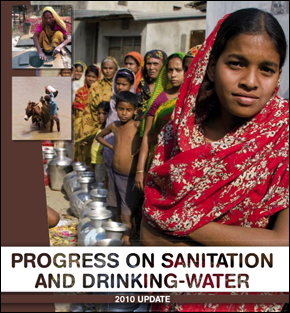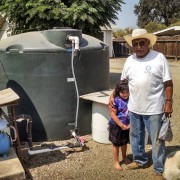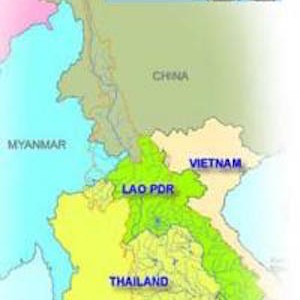Drinking Water Access on Target for Millennium Development Goals, while Sanitation Falls Short, Report Says
Even though access to drinking water is on the rise, the safety of those sources is in question.
 By Brett Walton
By Brett Walton
Circle of Blue
A new assessment report by the World Health Organization and UNICEF has found that the world is on track to surpass the Millennium Development Goal for drinking water access, but will fall short by one billion people for sanitation if current trends continue. The report also notes that access to an improved water source does not mean access to a quality water source.
The Progress on Sanitation and Drinking Water: 2010 Update finds that 2.6 billion people, more than one-third of the world’s population, do not use improved sanitation. Progress has been made in northern Africa, Southeast Asia and East Asia, but large parts of South Asia and Sub-Saharan Africa go without proper restroom facilities.
In 2000 the United Nations set goals for increasing access to safe drinking water and basic sanitation among the world’s poorest people. Known as the Millennium Development Goals (MDGs), they created quantified targets for improving life for these people by 2015.
The goals focused on poverty, health, hunger, education and gender equality, with the water and sanitation target aiming to half the proportion of people without access to safe drinking water and basic sanitation. This goal uses 1990 as a baseline year for comparison.
According to the UN definition, improved sanitation ensures that people do not come in contact with feces. Examples of such systems include flush and pour-flush toilets, ventilated pit latrines and composting toilets. Open defecation, the most unsanitary behavior, is declining, the WHO/UNICEF report states.
The report also found wide gaps between coverage in rural and urban areas for both drinking water and sanitation. More than eight out of ten people without improved water sources and seven out of ten people without adequate sanitation live in rural areas, according to the report.
People familiar with the report, which uses data gathered between 2007 and 2008, said it should be a call to action as the MDG deadline approaches.
“With only five more years to go until 2015, a major leap in efforts and investments in sanitation is needed today in order to have an impact by the time we carry out our end-of-MDG evaluation,” said Robert Bos, coordinator of Water, Sanitation, Hygiene and Health at WHO, in a press release.
But lack of investment in sanitation is often a matter of priority, said Maurice Bernard, head of the Water and Sanitation Department of the French Development Agency.
“No policymaker will tell you sanitation comes before drinking water,” Bernard said at World Water Day in Nairobi, Kenya. “In developing countries we are trying to solve many problems at same time with few financial resources.”
This emphasis on drinking water has led to an expansion in coverage, according to data in the report. Global access to an improved water source, defined as being protected from outside contamination, exceeds MDG targets. Nearly 1.7 billion people have gained new access since 1990. Improved sources include piped household connections, protected wells and springs, public taps, and boreholes.
However, the report acknowledges that there is no way of knowing whether the water coming from improved sources is actually higher in quality.
The requirements for an improved drinking water source assess the infrastructure used to access the water, while water source quality is another matter. The WHO allows its guidelines for microbial and chemical contamination to be modified by each country, so there is no global standard in place.
In an attempt to draw attention to this problem, the theme of World Water Day this year was water quality.
“We know how many people have access to water,” said the Prince of Orange during the event, “but we don’t know how many have safe water.”
A forthcoming WHO/UNICEF pilot study of country-level water quality testing found that 90 percent of piped systems met WHO microbial standards, but only 40 to 70 percent of other improved sources were in compliance.
The study also found that such water quality tests on a global scale were too expensive, especially considering the other ways in which the money could be spent.
Brett Walton is a reporter for Circle of Blue. Contact Brett Walton and follow more of his World Water Day coverage here.
Brett writes about agriculture, energy, infrastructure, and the politics and economics of water in the United States. He also writes the Federal Water Tap, Circle of Blue’s weekly digest of U.S. government water news. He is the winner of two Society of Environmental Journalists reporting awards, one of the top honors in American environmental journalism: first place for explanatory reporting for a series on septic system pollution in the United States(2016) and third place for beat reporting in a small market (2014). He received the Sierra Club’s Distinguished Service Award in 2018. Brett lives in Seattle, where he hikes the mountains and bakes pies. Contact Brett Walton










Leave a Reply
Want to join the discussion?Feel free to contribute!